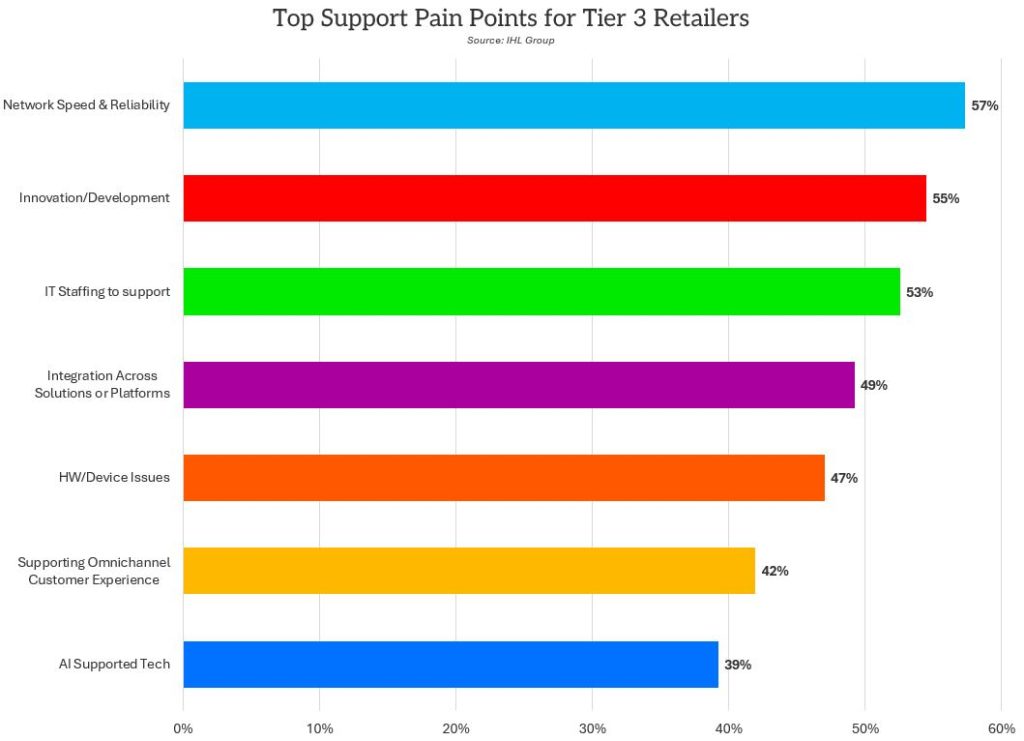Network Speed and Reliability: Significance for Tier 3 Retailers
The retail landscape, driven by technological advancements and changing consumer expectations, is evolving at a rapid pace. As the market moves towards more cloud and AI-driven solutions, Tier 3 retailers are facing a unique set of challenges. Our most recent study, done with our partner RIS News, revealed the support pain points for Tier 3 retailers. The top three are Network Speed and Reliability (57%), Innovation / Development (55%) and IT staffing (53%). These represent the most pressing concerns for these retailers.

The Significance of Network Speed and Reliability
Basically, network speed and reliability are critical for the success of any business, and this is especially true for retailers. Hence, a stable network infrastructure is essential for supporting various aspects of retail operations. Specifically, systems related to customer experience, supply chain, sales, and overall efficiency. Obviously, slow or unreliable networks can lead to lost sales, frustrated customers, and operational inefficiencies, ultimately impacting the bottom line.
Challenges Faced by Tier 3 Retailers
Tier 3 retailers tend to be capital constrained. This makes it difficult to remain current in terms of modern IT infrastructure and technology, and brings about a snowball effect. Simply, when an investment in IT is made, these retailers hope to hold onto those systems as long as possible. This results in the retailer constantly running the risk of being behind technically. Moreover, upgrades tend to happen late in the cycle. This means the retailer misses out on the benefits of constant integration across all systems that larger retailers enjoy. All together this can lead to performance issues, security vulnerabilities, and difficulty in keeping up with customer demands.
Solutions and Best Practices for Network Speed & Reliability
To address the challenges of network speed and reliability, Tier 3 retailers can consider implementing practical solutions and best practices. This includes investing in reliable network infrastructure, leveraging cloud-based solutions, and exploring managed services for optimal network performance. Additionally, retailers can prioritize IT staffing and training to ensure that they have the necessary expertise to manage and maintain their network infrastructure effectively.
Services availability, along with cash flow or availability of credit, all contribute to the pain points at this level. To address this, retailers can explore managed services, which can provide reliable support and maintenance for their critical systems. This in turn can ensure seamless operations and customer satisfaction.
The Future of IT in Tier 3 Retail
As the retail industry moves towards more cloud and AI-driven solutions, the future of IT in Tier 3 retail is poised for significant transformation. Simply, the best performing retailers (those with sales growth of over 10%) have continued to increase their IT spend at much higher levels than average and below-average retailers. This has led to more transformation and different issues for these retailers.
Innovation and integration across solutions are key priorities for winning retailers. That said, a strong emphasis on network speed and reliability reflects a proactive approach to maintaining robust IT infrastructure to support all their IT initiatives. As the market moves to more IT in the stores and the use of AI, these issues become more pressing. This underscores the critical role of a stable network infrastructure and adequate staffing to support the IT needs of smaller retailers.
Final Thoughts
Network speed and reliability are critical for the success of Tier 3 retailers, and addressing these challenges is essential for their long-term growth and sustainability. By prioritizing network infrastructure and IT staffing, and exploring innovative solutions, retailers can overcome these challenges and thrive in an increasingly digital and competitive market. As the industry continues to evolve, it is crucial for retailers to stay ahead of the curve and invest in the necessary IT infrastructure and solutions to support their operations and drive future growth.